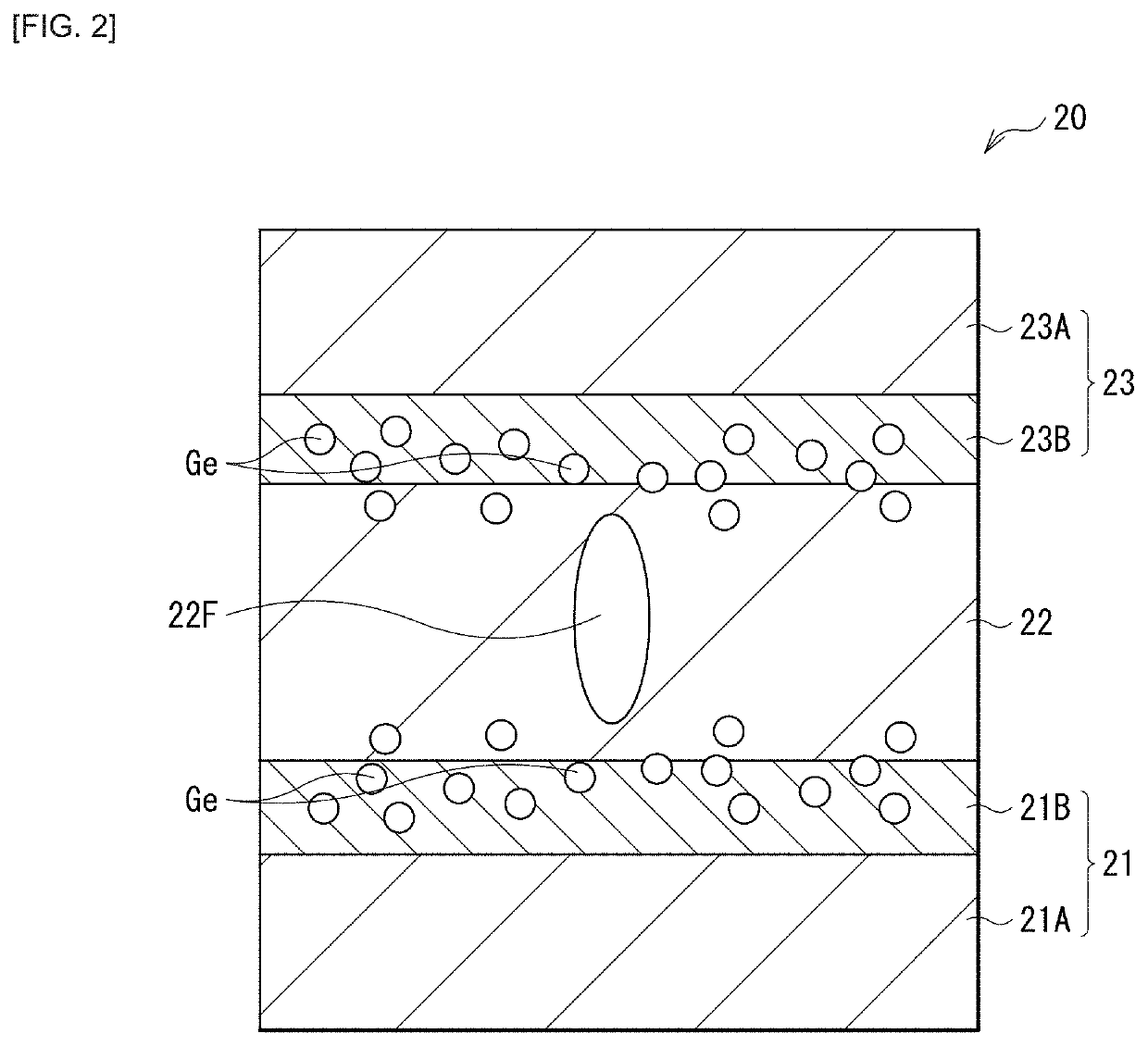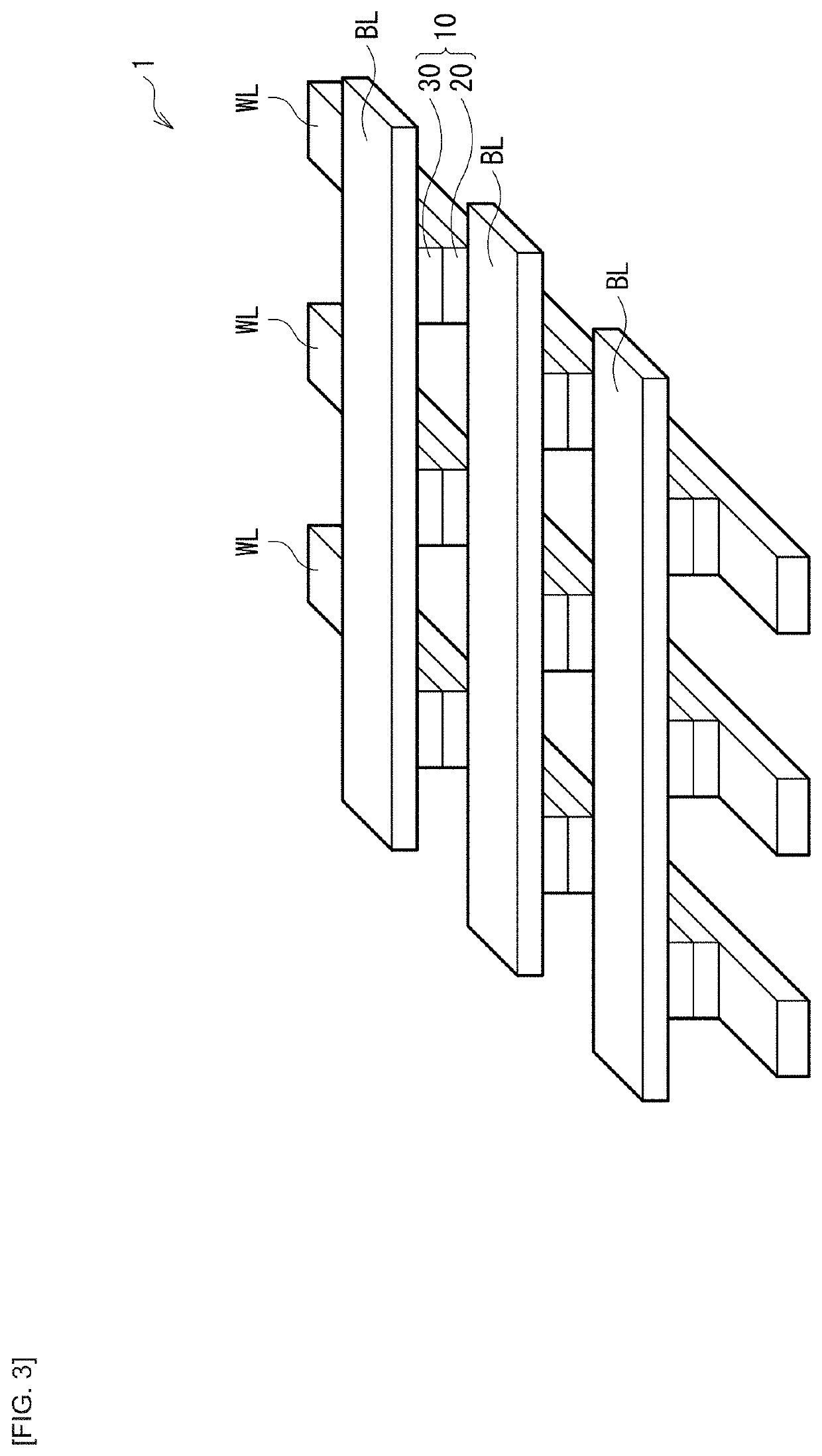Switching device and storage unit, and memory system
a technology of switching device and storage unit, which is applied in the direction of digital storage, semiconductor devices, instruments, etc., can solve the problems of large floor area per unit cell of resistive memory using access transistor, and it is not easy to increase the capacity of resistive memory, so as to achieve larger capacity, the floor area per unit cell is made smaller, and the capacity is increased.
- Summary
- Abstract
- Description
- Claims
- Application Information
AI Technical Summary
Benefits of technology
Problems solved by technology
Method used
Image
Examples
embodiment
1. Embodiment
1-1. Configuration of Switching Device
[0033]FIG. 1 illustrates an example of a cross-sectional configuration of a switching device (a switching device 20) according to an embodiment of the present disclosure. This switching device 20 is for selectively activating, for example, of a plurality of storage devices provided in a memory cell array 1 having a so-called cross-point array structure illustrated in FIG. 3, any one (a memory device 30; FIG. 3) of the plurality of storage devices. The switching device 20 is coupled in series to the memory device 30 (specifically, a memory layer 31), and includes a lower electrode 21 (a first electrode), a switching layer 22, and an upper electrode 23 (a second electrode) in this order. The switching device 20 of the present embodiment has a configuration in which the lower electrode 21 and the upper electrode 23 are configured as a stack of a metal layer 21A or 23A and a carbon-containing layer 21B or 23B; the carbon-containing laye...
modification examples
2. Modification Examples
2-1. Modification Example 1
[0075]FIG. 7 is a perspective view of an example of a configuration of a memory cell array 2 according to a modification example of the present disclosure. This memory cell array 2 has a so-called cross-point array structure as with the above-described memory cell array 1. In the present modification example, the respective memory layers 31 of the memory devices 30 extend along the bit lines BL extending in the same direction. The respective switching layers 22 of the switching devices 20 extend along the word lines WL extending in a direction different from the extending direction of the bit lines BL (for example, a direction orthogonal to the extending direction of the bit lines BL). At each of cross-points between the plurality of word lines WL and the plurality of bit lines BL, the switching layer 22 and the memory layer 31 are stacked through the intermediate electrode 41.
[0076]In this way, the switching devices 20 and the memo...
modification example 2
2-2. Modification Example 2
[0077]FIGS. 8 to 11 are perspective views of examples of respective configurations of memory cell arrays 3 to 6 having a three-dimensional structure according to modification examples of the present disclosure. In these memory cell arrays having a three-dimensional structure, the word lines WL extend in the same direction. The bit lines BL extend in the same direction that is a direction different from the extending direction of the word lines WL (for example, a direction orthogonal to the extending direction of the word lines WL). Furthermore, the plurality of word lines WL and the plurality of bit lines BL are each disposed in multiple layers.
[0078]In a case where the plurality of word lines WL is disposed to be divided into multiple layers, the plurality of bit lines BL is disposed in a layer between a first layer in which multiple word lines WL are disposed and a second layer that is adjacent to the first layer and multiple word lines WL are disposed t...
PUM
| Property | Measurement | Unit |
|---|---|---|
| thickness | aaaaa | aaaaa |
| thickness | aaaaa | aaaaa |
| thickness | aaaaa | aaaaa |
Abstract
Description
Claims
Application Information
 Login to View More
Login to View More - R&D
- Intellectual Property
- Life Sciences
- Materials
- Tech Scout
- Unparalleled Data Quality
- Higher Quality Content
- 60% Fewer Hallucinations
Browse by: Latest US Patents, China's latest patents, Technical Efficacy Thesaurus, Application Domain, Technology Topic, Popular Technical Reports.
© 2025 PatSnap. All rights reserved.Legal|Privacy policy|Modern Slavery Act Transparency Statement|Sitemap|About US| Contact US: help@patsnap.com



